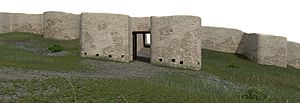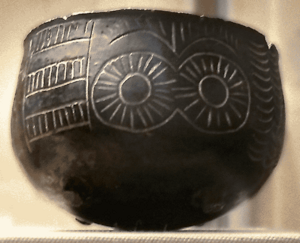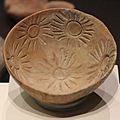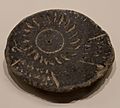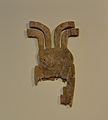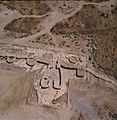Los Millares facts for kids
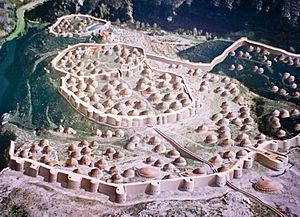
A model of the prehistoric town of Los Millares, with its walls.
|
|
| Location | Santa Fe de Mondújar, Province of Almería, Andalusia, Spain |
|---|---|
| Coordinates | 36°57′53″N 02°31′20″W / 36.96472°N 2.52222°W |
| Type | Settlement |
| Area | 2 ha (4.9 acres) |
| History | |
| Periods | Chalcolithic |
Los Millares is an ancient settlement in Spain. It is located about 17 kilometers (10.5 miles) north of Almería. This site was used during the Copper Age, from around 3000 BC to 2000 BC. About 1000 people likely lived here.
Workers found Los Millares in 1891 while building a railway. Luis Siret, an archaeologist, started digging there soon after. Digs are still happening today. Los Millares is a very important place for understanding the Copper Age culture, known as the Millaran culture.
Contents
What Was Los Millares Like?
The site covers about 2 hectares (5 acres). It has three big stone walls built in circles. The outer wall is the longest, stretching over 200 meters (650 feet). It had 19 strong towers, called 'bastions', and a main gate with extra defenses.
Four smaller stone forts guarded the road leading to the main settlement. There was also a large cemetery with 80 passage grave tombs. These tombs are long corridors leading to a burial chamber. Scientists used Radiocarbon dating to find out that one wall was rebuilt around 3025 BC.
Inside the walls, there were many simple homes. There was also a large building where people melted copper. This shows they knew how to work with metals. Archaeologists found many pots and bowls at the site. Some had special eye-like designs, called oculus motifs. Similar designs were found on carved stone figures.
The people of Los Millares were mostly farmers. But they also learned how to work with copper. This was a huge step forward! Los Millares is key to understanding how people moved from the Stone Age to the Bronze Age. The Millaran culture eventually became very important across the Iberian Peninsula.
Experts believe about 1000 people lived at Los Millares between 3200 BC and 2300 BC. The huge amount of stone used and the clever design of the walls show that the site was built for defense and power.
How Los Millares Connected with Other Cultures
Los Millares was part of bigger trends in Europe, like building huge stone structures (called Megaliths) and the Beaker culture. Archaeologists studied items from the 70 tholos tombs at Los Millares. These tombs had special stone slabs with round holes.
The finds suggest that the people of Los Millares lived in a society with different social groups. They also needed strong defenses, showing they might have had conflicts with nearby groups. Around 1800 BC, the Los Millares culture was replaced by the El Argar civilization. This new culture brought the Bronze Age to the area. Another similar culture from that time was found in Vila Nova de São Pedro in Portugal.
Other ancient settlements in this area, like Los Silillos and sites in Sierra de Cabrera, are similar in age to Los Millares. Some people have also noticed similarities between the buildings at Los Millares and a step pyramid in Sardinia called Monte d'Accoddi.
Protecting Los Millares
The site of Los Millares has been protected since 1931. It is now a Bien de Interés Cultural, which means it's a very important cultural site.
There is a special center at the site where you can learn more about it. Some of the things found at Los Millares are shown at the National Archaeological Museum in Madrid. Others are at the Museum of Almería.
Gallery
See also
 In Spanish: Los Millares para niños
In Spanish: Los Millares para niños



